-
 Bitcoin
Bitcoin $107,618.5142
0.12% -
 Ethereum
Ethereum $2,512.1843
3.14% -
 Tether USDt
Tether USDt $1.0002
0.00% -
 XRP
XRP $2.2947
5.02% -
 BNB
BNB $659.4274
1.65% -
 Solana
Solana $157.2227
4.00% -
 USDC
USDC $0.9999
0.00% -
 TRON
TRON $0.2799
1.47% -
 Dogecoin
Dogecoin $0.1672
1.83% -
 Cardano
Cardano $0.5843
4.56% -
 Hyperliquid
Hyperliquid $40.9315
7.47% -
 Bitcoin Cash
Bitcoin Cash $515.7593
5.04% -
 Sui
Sui $2.8141
0.66% -
 Chainlink
Chainlink $13.6128
2.03% -
 UNUS SED LEO
UNUS SED LEO $9.1190
0.81% -
 Avalanche
Avalanche $18.1610
0.63% -
 Stellar
Stellar $0.2405
2.09% -
 Toncoin
Toncoin $2.9537
2.61% -
 Shiba Inu
Shiba Inu $0.0...01157
0.32% -
 Litecoin
Litecoin $86.7711
0.11% -
 Hedera
Hedera $0.1520
2.24% -
 Monero
Monero $319.9130
2.90% -
 Polkadot
Polkadot $3.4451
0.54% -
 Dai
Dai $1.0000
0.01% -
 Bitget Token
Bitget Token $4.5506
-1.01% -
 Ethena USDe
Ethena USDe $1.0001
-0.01% -
 Uniswap
Uniswap $7.2587
0.73% -
 Aave
Aave $282.7954
3.27% -
 Pepe
Pepe $0.0...09926
2.91% -
 Pi
Pi $0.5128
-2.62%
How to interpret the KDJ J value being oversold for three consecutive days but the negative line entity enlarged?
When the KDJ indicator's J line is oversold for three consecutive days in crypto trading, it may signal a potential bullish reversal, but traders should confirm with price action and volume before making decisions.
Jun 30, 2025 at 11:07 pm

Understanding the KDJ Indicator in Cryptocurrency Trading
The KDJ indicator, also known as the Stochastic Oscillator, is a momentum-based technical analysis tool widely used in cryptocurrency trading. It helps traders identify overbought and oversold conditions, potential trend reversals, and momentum shifts. The KDJ consists of three lines: the K line (fast stochastic), the D line (slow stochastic), and the J line (divergence value).
Each line plays a distinct role in interpreting price action. The J line, in particular, is derived from the formula:
J = 3 × K - 2 × D
This line often acts as a signal for extreme market conditions and can indicate when a reversal may be imminent.
What Does It Mean When the J Value Is Oversold for Three Consecutive Days?
When the J value drops below 0 for three consecutive days, it signals that the asset has entered a deeply oversold condition. In traditional technical analysis, this is interpreted as a sign of potential bullish reversal due to excessive selling pressure being exhausted.
However, in the context of cryptocurrency markets, which are highly volatile and often influenced by sentiment and macroeconomic factors, such readings should not be taken in isolation. A prolonged oversold J value could suggest either an extended downtrend or a consolidation phase where buyers are hesitant to enter despite apparent undervaluation.
Why Does the Negative Line Entity Enlarge During This Period?
The term "negative line entity enlargement" refers to the increasing length or strength of bearish candlesticks on the price chart during the period when the J line remains oversold. This phenomenon appears contradictory at first glance because one would expect prices to rebound after a prolonged oversold condition.
There are several possible explanations for this behavior:
- Market Sentiment Overpowering Technical Indicators: In crypto markets, fear and panic can drive prices lower regardless of technical indicators suggesting oversold levels.
- Large Whales or Institutional Selling Pressure: Big players might continue dumping assets even when short-term indicators show oversold conditions.
- Absence of Buying Volume: If there's no significant buying volume to counteract the selling pressure, the negative line entities will continue to grow.
This divergence between the oversold J line and increasing bearish candlestick size suggests a lack of immediate support and a stronger-than-expected downtrend.
How to Analyze Price Action Alongside the KDJ J Line
To properly interpret this scenario, traders must analyze price action in conjunction with the KDJ indicator. Here’s how you can do that step-by-step:
- Identify the Trend Context: Determine whether the market is in a downtrend, uptrend, or sideways movement. A deep oversold J line in a strong downtrend may not result in an immediate reversal.
- Check Volume Patterns: Look for any increase in volume during the period of oversold J values. A sudden surge in volume without a corresponding price rise might indicate accumulation or distribution.
- Look for Divergence Between Price and J Line: If the price continues to make new lows but the J line starts to rise, it could signal hidden bullish momentum.
- Use Support Levels as Confirmation Points: Check if key support zones align with the current price level. If so, the likelihood of a bounce increases.
By combining these observations, traders can better understand whether the market is simply extending its bearish move or preparing for a reversal.
Strategies for Trading This Scenario in Crypto Markets
Trading based solely on the KDJ J line being oversold for multiple days is risky, especially when the negative line entity continues to expand. Instead, consider the following strategies:
- Wait for Confirmation Candles: Before entering a long position, wait for a bullish engulfing pattern or a strong positive candlestick that closes above the recent swing high.
- Combine with Moving Averages: Use the 50-period and 200-period moving averages to assess the broader trend. If the price is below both, avoid aggressive long entries.
- Set Tight Stop Losses: Due to the high volatility in crypto, always place stop losses just below the most recent swing low to manage risk effectively.
- Use Multi-Timeframe Analysis: Check higher timeframes like the 4-hour or daily chart to confirm if the oversold condition is part of a larger cycle or merely noise within a downtrend.
These strategies help filter out false signals and improve the probability of successful trades.
Frequently Asked Questions (FAQ)
Q1: Can the KDJ J line stay oversold indefinitely in crypto markets?
Yes, especially during strong downtrends or periods of intense sell-off. Unlike traditional markets, crypto can remain oversold for extended periods due to algorithmic trading and emotional investor behavior.
Q2: Should I buy just because the J line is oversold for three days?
No. Always look for additional confirmation such as price action, volume spikes, or confluence with other indicators before making a trade decision.
Q3: How does the J line differ from the RSI in identifying oversold conditions?
While both indicators identify overbought/oversold conditions, the J line reacts more sharply and is prone to giving early signals. The RSI provides smoother readings and is often preferred for gauging momentum over longer periods.
Q4: Is the KDJ indicator reliable on lower timeframes in crypto trading?
It can be, but it tends to generate more false signals on lower timeframes due to increased volatility and noise. It's best used on the 1-hour chart or higher for more reliable readings.
Disclaimer:info@kdj.com
The information provided is not trading advice. kdj.com does not assume any responsibility for any investments made based on the information provided in this article. Cryptocurrencies are highly volatile and it is highly recommended that you invest with caution after thorough research!
If you believe that the content used on this website infringes your copyright, please contact us immediately (info@kdj.com) and we will delete it promptly.
- OKX and Binance Delist Trading Pairs: What's Going On?
- 2025-07-01 02:30:12
- Pepeto vs. Shiba Inu: Can the New Meme Coin Dethrone the King?
- 2025-07-01 02:50:11
- Meme Coin Mania: Pepeto, Pepe, and Shiba Inu Race to Dominate July 2025
- 2025-07-01 03:50:12
- Saylor, Bitcoin, Holdings: Strategy's Crypto Empire Grows
- 2025-07-01 02:30:12
- Ruvi AI: The Audited Token Set to Outshine Shiba Inu?
- 2025-07-01 03:55:12
- BONK's Double Bottom Dance: Will Critical Support Hold?
- 2025-07-01 04:00:22
Related knowledge
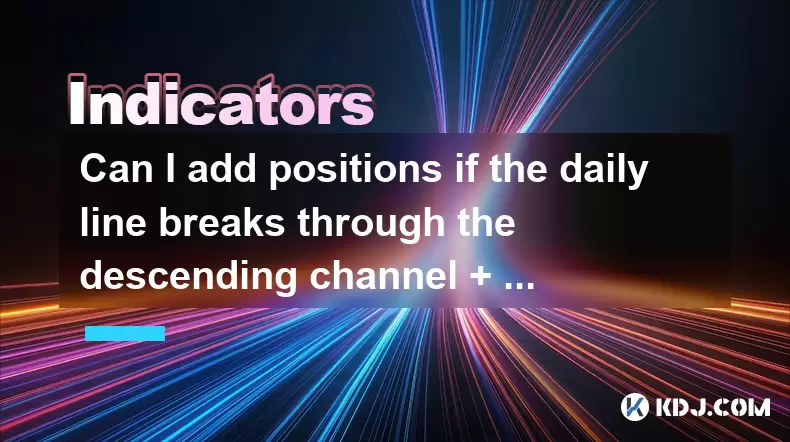
Can I add positions if the daily line breaks through the descending channel + the 30-minute moving average is in a bullish arrangement?
Jun 30,2025 at 11:00pm
Understanding the Descending Channel BreakoutWhen a daily line breaks through a descending channel, it indicates a potential shift in market sentiment from bearish to bullish. A descending channel is formed by drawing two parallel trendlines, where the upper trendline connects the lower highs and the lower trendline connects the lower lows. A breakout o...
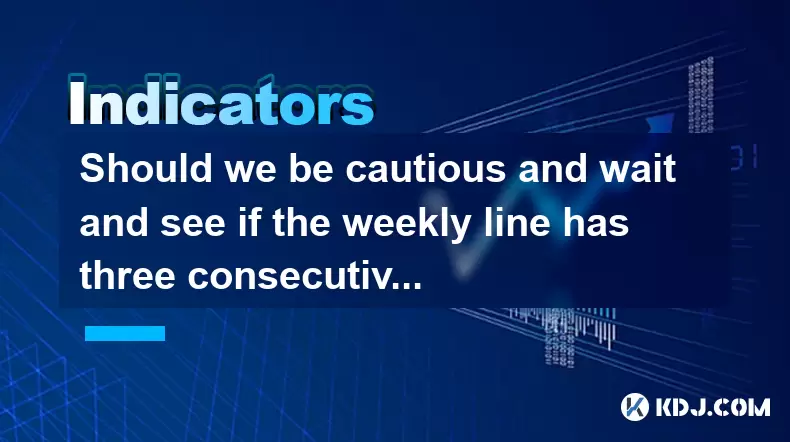
Should we be cautious and wait and see if the weekly line has three consecutive Yin lines + the daily MACD green column enlarges?
Jul 01,2025 at 12:42am
Understanding the Weekly Three Consecutive Yin Lines PatternIn technical analysis, three consecutive Yin lines on a weekly chart indicate a strong bearish trend. Each Yin line represents a week where the closing price is lower than the opening price, signaling consistent selling pressure. When this pattern appears three times in succession, it often sug...
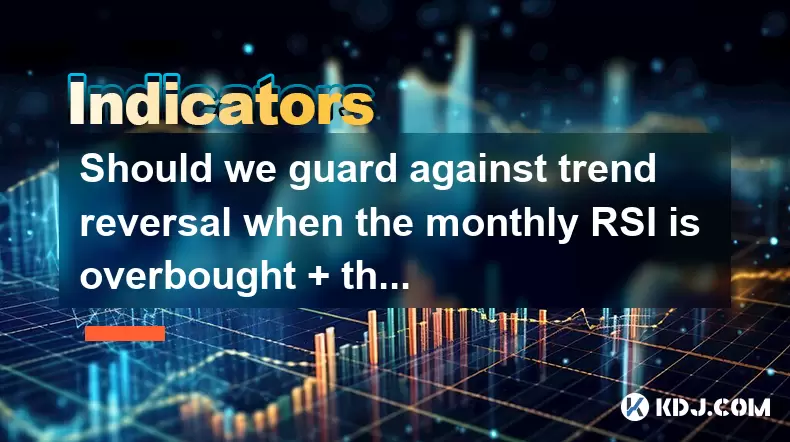
Should we guard against trend reversal when the monthly RSI is overbought + the weekly line has a long upper shadow?
Jun 30,2025 at 11:35pm
Understanding RSI Overbought Conditions in CryptocurrencyThe Relative Strength Index (RSI) is a momentum oscillator commonly used in technical analysis to identify overbought or oversold conditions in an asset. When the monthly RSI of a cryptocurrency reaches above 70, it is generally considered overbought, suggesting that the asset may be due for a pul...
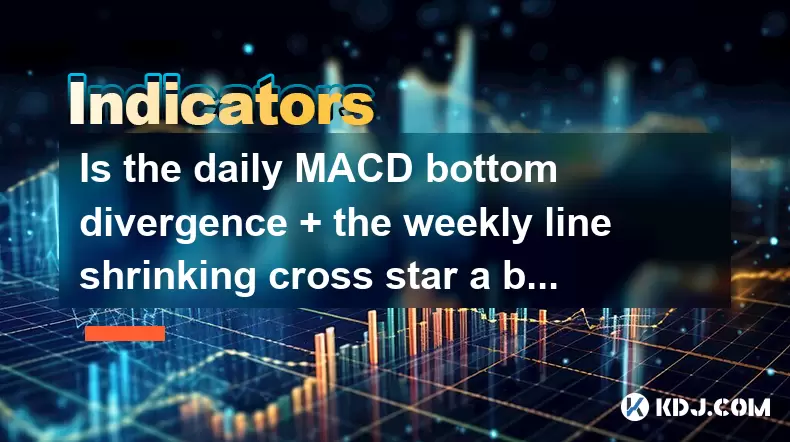
Is the daily MACD bottom divergence + the weekly line shrinking cross star a bottoming signal?
Jul 01,2025 at 03:49am
Understanding MACD Bottom Divergence in Cryptocurrency TradingThe Moving Average Convergence Divergence (MACD) is a widely used technical indicator among cryptocurrency traders to identify potential trend reversals. A bottom divergence occurs when the price of an asset makes a lower low, but the MACD line forms a higher low. This suggests that bearish m...
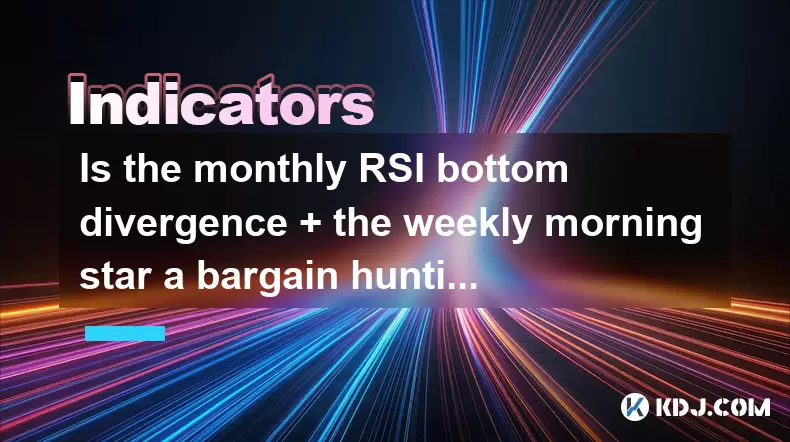
Is the monthly RSI bottom divergence + the weekly morning star a bargain hunting opportunity?
Jun 30,2025 at 09:57pm
Understanding RSI Bottom Divergence in Monthly TimeframesThe Relative Strength Index (RSI) is a momentum oscillator commonly used to identify overbought or oversold conditions in the market. When traders refer to a monthly RSI bottom divergence, they're observing a situation where the price makes a lower low, but the RSI makes a higher low on the monthl...
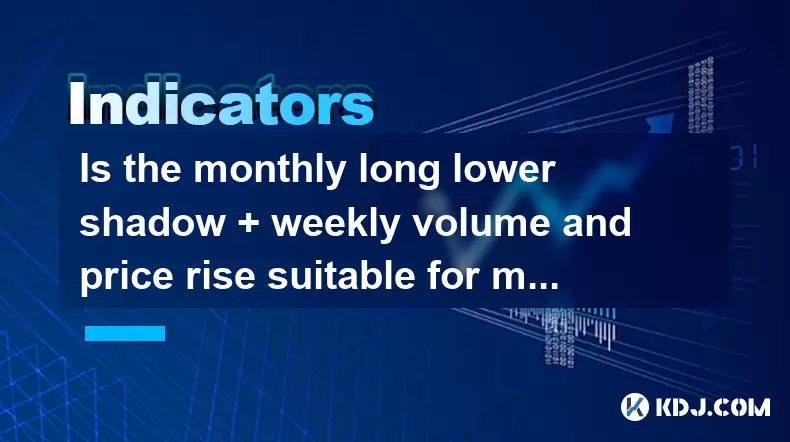
Is the monthly long lower shadow + weekly volume and price rise suitable for mid-term layout?
Jul 01,2025 at 01:29am
Understanding the Monthly Long Lower Shadow PatternA monthly long lower shadow candlestick pattern occurs when the price of a cryptocurrency drops significantly during the month but then rebounds to close near or above the opening price. This creates a candle with a long wick below and a relatively small body. In technical analysis, this pattern is ofte...

Can I add positions if the daily line breaks through the descending channel + the 30-minute moving average is in a bullish arrangement?
Jun 30,2025 at 11:00pm
Understanding the Descending Channel BreakoutWhen a daily line breaks through a descending channel, it indicates a potential shift in market sentiment from bearish to bullish. A descending channel is formed by drawing two parallel trendlines, where the upper trendline connects the lower highs and the lower trendline connects the lower lows. A breakout o...

Should we be cautious and wait and see if the weekly line has three consecutive Yin lines + the daily MACD green column enlarges?
Jul 01,2025 at 12:42am
Understanding the Weekly Three Consecutive Yin Lines PatternIn technical analysis, three consecutive Yin lines on a weekly chart indicate a strong bearish trend. Each Yin line represents a week where the closing price is lower than the opening price, signaling consistent selling pressure. When this pattern appears three times in succession, it often sug...

Should we guard against trend reversal when the monthly RSI is overbought + the weekly line has a long upper shadow?
Jun 30,2025 at 11:35pm
Understanding RSI Overbought Conditions in CryptocurrencyThe Relative Strength Index (RSI) is a momentum oscillator commonly used in technical analysis to identify overbought or oversold conditions in an asset. When the monthly RSI of a cryptocurrency reaches above 70, it is generally considered overbought, suggesting that the asset may be due for a pul...

Is the daily MACD bottom divergence + the weekly line shrinking cross star a bottoming signal?
Jul 01,2025 at 03:49am
Understanding MACD Bottom Divergence in Cryptocurrency TradingThe Moving Average Convergence Divergence (MACD) is a widely used technical indicator among cryptocurrency traders to identify potential trend reversals. A bottom divergence occurs when the price of an asset makes a lower low, but the MACD line forms a higher low. This suggests that bearish m...

Is the monthly RSI bottom divergence + the weekly morning star a bargain hunting opportunity?
Jun 30,2025 at 09:57pm
Understanding RSI Bottom Divergence in Monthly TimeframesThe Relative Strength Index (RSI) is a momentum oscillator commonly used to identify overbought or oversold conditions in the market. When traders refer to a monthly RSI bottom divergence, they're observing a situation where the price makes a lower low, but the RSI makes a higher low on the monthl...

Is the monthly long lower shadow + weekly volume and price rise suitable for mid-term layout?
Jul 01,2025 at 01:29am
Understanding the Monthly Long Lower Shadow PatternA monthly long lower shadow candlestick pattern occurs when the price of a cryptocurrency drops significantly during the month but then rebounds to close near or above the opening price. This creates a candle with a long wick below and a relatively small body. In technical analysis, this pattern is ofte...
See all articles

























































































